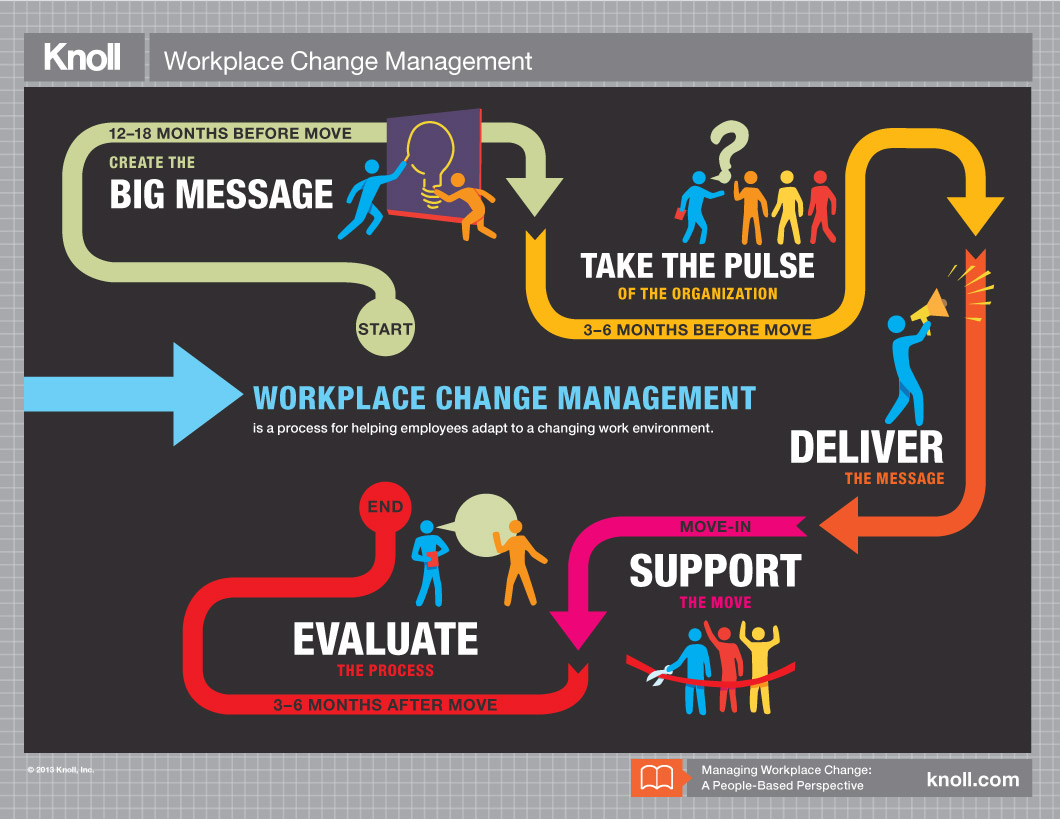Do you really know what others are thinking about the change you're managing?
I think this cartoon is supposed to illustrate the many ways in which people will resist a proposed change in the workplace. It does - and it definitely covers most of the most common resistance responses you can expect to any change initiative.
However, what struck me most about this particular illustration is that while one person is standing there doing the talking, 11 other people are having private thoughts. Not all of them are negative, and not all of them will ever be shared with the person leading the change or even with the other people around the table. And this is where change can run into serious problems.
Most of us know that feedback is important in the change process. But as I've mentioned before, we shouldn't be too quick to dismiss change resistors, because they very often have something to teach us. Maybe they do have a better idea; maybe they have an important piece of information that should be taken into consideration when mapping out and implementing a change strategy; maybe they're just an indicator that the organizational culture and communications need a lot of work before any change can really take root and be successful. But as long as only one person is communicating while 11 others are silent, no amount of expert change management will make a change initiative successful.

More than words can say: Communication that will help your career
In my opinion, the single biggest determining factor in whether a change initiative is successful or not is communication. Communication across the leadership team, communication from leadership to managers and employees – and communication from people on the front lines back to management.
The challenge is that good communication is never a one-way street: It requires that everyone in the chain has good communication skills, from the most junior intern right up to the C-suite heavy-hitters.
You may not be able to change everyone in your organization, but you might be surprised to find that improving your own communication skills can have a positive effect on those around you. Here are some tips:

Communication tips for everyone, no matter what their role in the organization:
- Be respectful
- Be a great listener (and acknowledge that you’re listening)
- Remember that communication is two-way (listen and respond)
- Speak so others can hear you (put it in terms your audience will understand and appreciate)
Tips for Recipients (individual contributors):
- Ask questions to get the information you need
- Communicate as positively with peers as with those above you
- Speak so others can hear you (and pay attention to the channel they respond to best)
- Listen so others will want to talk to you
Tips for Translators (supervisors/managers):
- Listen – so your employees will talk to you
- Take information from above and convey it clearly to those below you
- Use positive communication to build teams (both the one you manage and the management team you’re part of)
- Don’t overload your team – be concise, not overwhelming
- Learn to ‘hear between the lines’
- Understand company direction and help your staff understand it
Tips for Synthesizers (directors/vice-presidents):
- Listen for clarity from above
- Listen with compassion from below
- Synthesize information into a ‘narrative’ or ‘story’ that helps you move your teams toward their goals
- Use the right filter for what you’re hearing (understand the subtext)
- Communicate so your boss will hear you (be strategic)
- Communicate so employees will want to listen to you (be engaging)
- Communicate to strengthen alliances with your peers (be a valued source of insight)
Sounds simple when it’s here in bullet points, doesn’t it? But great communication really requires reflection and a conscious effort to understand the person (or people) to whom you’re communicating – it’s really about getting in the habit of making that effort on a day-to-day basis.
Making change communication compelling
On my more or less constant quest for interesting change management items, I came across this infographic today:

Now, Knoll is a company which specializes in office furniture (or perhaps they'd prefer to call it 'workplace environment design'), so their core competency isn't change management. However, if you're a supplier involved in a refit of an office of hundreds or thousands of people, you're going to need to know something about change management - because no matter how beautiful your 'office environments' are, getting a whole lot of people packed up, moved and settled, without losing a lot of productivity, requires quite a lot of change to be managed.
This content of this particular infographic isn't particularly earth-shattering - communication, input, messaging, supporting and evaluating are all pretty standard components of any change initiative - but what I liked about it was how aethetically pleasing it is, and how it makes clear that even an office move requires a 12-18 month lead time in terms of communicating the Big Idea to the organization. In my experience, if organizations did a better job of creating compelling communications, and put them in place earlier in the change process, almost every change initiative would go a heck of a lot more smoothly and with more enthusiastic buy-in throughout the process. After all, it's hard for people to keep resisting something that looks so appealing, especially if it's been announced months - or years - in advance.
Just something to think about.
Four change management books (I think) you should read
If you're like me, you probably have a stack of business books somewhere in the corner of your office, just waiting for the mythical day (or month) when you have nothing else to do but read. Except that when you finally make some time, you discover that most of those books have one or two good points, buried in a whole lot of stuff you already knew or which isn't all that relevant to your day-to-day working life.
That's why, when Bruno Gebarski asked me the other day for my recommendations on great change management books, I didn't have to think too hard about my choices. There are lots of business change management books out there, but only a handful that I read cover to cover, and refer to and reference often in my work. If you don't have time to read any other change management books this year, these will give you lots to work with.
Aftershock: Helping People Through Corporate Change
by Harry Woodward & Steve Buchholz

This is my all-time favorite book about change, and in many ways it's the first book which really addressed the issues around what happens to the people in an organization when they're faced with huge changes. Even though it was written in 1987, the points the authors make about how to manage people through change are still relevant today, and I find myself referring to Woodward & Buchholz's principles time and again. If you want to understand - and I mean really understand - the people side of change, this is the book for you.
Leading Change
by John P. Kotter

Of course, you can't talk about change management writers without talking about John Kotter. He's been one of the leading voices in the field for years now. I have to admit that I'm not the most passionate devotee of Kotter, but I really like this book because it speaks the language of business. I can reference it with my clients - some of whom are familiar with Kotter already, from conferences or workshops - and they understand immediately. I also use his concept of a 'guiding coalition' (making sure you have a team comprised of people with the right amount of power, expertise, credibility and leadership) on all my projects - it's one of those practical tips that make a huge difference no matter what kind of change initiative you're undertaking.
Managing Transitions: Making the Most of Change
by William Bridges

First published in 1995, this book is now in its 3rd edition, which gives you some idea of just how useful it must be. It's designed for employees and managers, to help them get through change by understanding, accepting and even embracing the new status quo. Not every change fits into the 'transition' category, but I find the model particularly useful in cases where the change initiative has potentially negative implications for individuals. I also use it when I work with my executive coaching clients - we don't go step-by-step through Bridges' model, but I use the principles to help clients who are in that space between 'endings' and 'beginnings'.
ChangeSmart: Implementing Change Without Lowering Your Bottom Line
by Beth Banks Cohn

What would this list be without a shameless plug for one of my own books? Written for middle- and higher-level managers, this book is all about leveraging the power of your employees to help a change go more smoothly and productively, and with the best possible effect on the bottom line of the organization. It's got a field-tested framework that can be applied to almost any business project plan, has real-life examples, and, best of all, it can be read in under 2 hours!
What about you? Which change-related books have been most influential in your day-to-day work? (Share your recommendations on Twitter @BethBanksCohn.)
Does the Right Hand Know What All the Other Hands are Doing?
The senior management of the organization has done a thorough analysis and assessment, and everyone's agreed: The sales department is holding up the rest of the organization, and needs some radical change.
So you redraw the sales territory boundaries, give them some new CRM software, write a new sales training program and hold a 2-day retreat designed to get all the salespeople engaged in the new system. It seems to be working and everyone in the sales department is excited to be moving forward.
But...a month after the changes take effect, you discover that the supply chain is in disarray, the accounting department is fuming because they aren't getting invoices in a timely manner, and the entire customer service team is about to mutiny because they're getting so many angry calls from clients.
What the heck happened?
You forgot that changes to the Sales organization didn't happen in a vacuum. When you changed the way Sales functioned within the organization, you changed the way the whole organization worked. When Sales changed the way they processed orders, it had in impact on the way Accounting processed them; when Sales put a big push on Product X, that had an impact on the way Supply Chain sourced it; and when Sales changed the message it communicated to customers, it had an impact on Customer Service.
At its core, change management is really about being able to see the big picture and mapping out how a change - or a set of changes - in one area is going to affect other areas of the organization, and what needs to happen in order for all the elements to work together effectively.
When proposing a change that seems to affect only one department or division, here are some questions to ask:
- How will this change affect the day-to-day activities of the key roles within this department?
- How will this change affect the day-to-day activities of key roles in other departments?
- Can we draw before and after process maps of key procedures within the organization to identify what will happen as a result of these changes?
- Have we asked for input from key stakeholders in other departments to help identify how a change in Department A will affect Departments B-F?
- What communication and training will other departments/divisions need in order to be working in concert on Day 1 of the change?
Asking these questions - and taking the time to plan for the answers - can add a little time at the outset of a change initiative, but I guarantee they'll save time (and headache) when the change starts to take effect.
Inside Out: When Internal Communications Go External
6 ways to get ahead of the problem
It's every CEO's worst nightmare. You're in the midst of a change initiative, but you've had to make some tough decisions, and a few people have been asked to leave. But you're sticking to the plan, and you think things are going as well as can be expected. You can see the light at the end of the tunnel.
Then one of your best clients calls to say that they're worried about next year's contract and thinking about reducing their spend with you. You reassure them that everything is fine - and you think that it is. But then you hear from a supplier who's wondering if you're still going to be paying your invoices on time, and expressing concern about their long-term relationship with you.
You're perplexed - until you happen to call a former colleague with whom you've stayed friendly and he greets you with, "What the hell is going on over there? I hear you won't be around this time next year!"

And suddenly you discover that a couple of employees involved in the change have been more confused and disgruntled than you realized. They've been spreading the word, and it hasn't been positive. They've been so vocal, in fact, that the word on the street is that your organization is on a collision course with disaster - and that's starting to make your clients, suppliers and other stakeholders nervous.
So what do you do, before someone forwards a confidential email to the competition, or, worse, decides to pen an op-ed about the state of affairs in a daily newspaper?
Managing change communications in a crisis
1. Don't panic. When you start hearing negative rumors from a couple of different sources, you can start to think that 'the whole world' is saying you're about to capsize, or that your entire workforce is staging a mutiny. Chances are, things aren't that bad, and you've probably caught it early. So don't go into full-on crisis mode until you've had a chance to speak to your senior management team and get an accurate assessment.
2. Don't look for scapegoats. You're probably feeling betrayed and angry, but looking for someone to blame, fire or castigate is only going to exacerbate the problem. What's really happening is that you're getting negative feedback about the change - you're just not getting it through the most productive channels. But negative feedback can be a good opportunity to gain insight about how the change is being implemented - so instead of looking for someone to blame, look for the opportunity the situation is providing you to improve the change.
3. Help employees to see the big picture. When quite a few of your employees are speaking to outsiders in a negative way, it's usually a good sign that they don't really understand why the changes are happening or why they're a good thing for the organization. So you probably need to beef up your messages about what these changes mean for the long-term health of the company.
4. Help employees to see the little picture. If the source of the negative messages is a handful of people or a specific department, it's likely that those people or that department is feeling disengaged from the change or that they're being shortchanged in some way. Arrange for one-on-one (or one-on-small-team) mentoring and communication to help thosse people understand their role in the changes and how their full participation is important.
5. Be as honest as possible, as often as possible. I've said it before and I'll say it again: During a change process, it's virtually impossible to communicate too much or too often. The more honest information you can share with employees, the more likely they are to 'get' the reasons for the change, and the less likely they are to spread negative messages outside the organization.
6. Revisit your communication plan. It's always better to prevent a crisis than to have to address it after the fact - that's why every change management initiative should have a well-defined communication plan built into the overall strategy. However, if you find yourself facing challenges, don't just go into defensive mode: Revisit your communication plan and make adjustments (more communications, additional channels, refined messages) as required.

